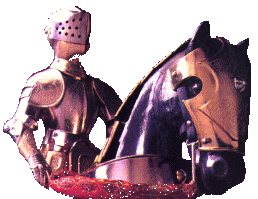|
|
|

|
|
|
Medieval Armors, Helmets, and Shields As prehistoric man went into battle he found the need to protect himself from injury. Early items used as armor consisted of hardened tree bark, tortoise shells and thick animal pelts. The design of armor saw its true birth during the Roman Empire. Fastening plates of steel, iron and brass together, the Romans introduced Scalemail. It was effective and protective. Other designs included Splintmail which was a series of contoured plates that fit around the arms, shins and thighs in sections. These were buckled and strapped into place. Soon weapons began improving to increase the chances of overcoming the armor. As such, protective wear began updating itself to meet the needs. Ringmail was an early experiment at linking metal hoops together in the form of a tunic. Though this was effective against most slashing weapons, it did little to prevent direct stab wounds. Thus it was modified into Chainmail armor which saw its popularity in the early 10th Century. Chainmail was an improvement upon the Ringmail idea, however the linked rings of metal were smaller, thus disallowing a sword to penetrate deeply on its wearer. Though these armors were useful and the best the time period had to offer, the craftsmanship, materials and time it took to make was indeed costly. As not all people could afford such expensive armors, other means of protection were developed for the poor. Leather armor, along with padded and studded armor became popular.
|
|
|
|
|